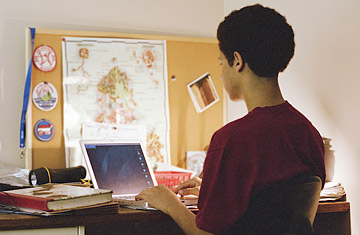
Do students have a First Amendment right to make fun of their principals and teachers on Facebook and other social-media sites? Or can schools discipline them for talking out of school?
In a pair of free-speech rulings, a federal appeals court in Pennsylvania last week came down on the side of the students. In both cases, the court said that schools were wrong to suspend students for posting parodies of their principals on MySpace — one in which a boy made fun of his principal's body size, and another in which a girl made lewd sexual comments about her principal.
The speech in these cases is the sort of derisive put-down of authority figures that students have always engaged in. In the past, kids used to say these things to each other in the cafeteria or at recess, or pass them in notes during class.
Now, they post their digs on social-media sites — where principals and teachers can sometimes see them. With the explosion of Facebook, Twitter, and other online forums for self-expression, the issue of what rights students have on these sites is a critical free-speech issue — as important, arguably, as what speech rights they have in the school building.
In the Pennsylvania MySpace cases, the court struck just the right balance. It said schools have a legitimate interest in preventing educational disruption, but they have no right to clamp down on students' online speech simply because they do not like it.
Justin Layshock, a high school senior in western Pennsylvania, created a MySpace profile in 2005 that purported to be from his principal. It was not particularly clever stuff. A major theme was the use of the word big, an apparent reference to the man's size.
The principal found the way he was described to be "degrading" and "demoralizing." Justin's parents agreed, and when they found out, they grounded him. Justin, of his own accord, went to the principal's office and apologized.
The matter could have ended there — but it didn't. The school found Justin guilty of violating its discipline code. It suspended him for 10 days, and for the rest of the year assigned him to its Alternative Education Program, for students with behavioral and educational problems.
In a second case, a middle-school girl from a school district in eastern Pennsylvania created a MySpace profile of her principal that was cruder. The girl — who was not identified by name in the ruling — used the principal's photo, but presented him as a bisexual Alabama middle-school principal named "M-Hoe." The profile, which she created in 2007, described the principal in coarse terms, and said he "enjoyed hitting on students and their parents."
The principal was irate. He suspended the girl for 10 days, the same punishment he gave students who took knives to school, and had the state police call her and her parents in to discuss her actions.
The question of how much free speech students have is a fraught one. In 1969, in the landmark case of Tinker v. Des Moines Independent Community School District, the Supreme Court held that a school violated students' First Amendment rights when it suspended them for wearing black arm bands to protest the Vietnam War. In a famous phrase, the court declared that students "do not shed their constitutional rights to freedom of speech or expression at the schoolhouse gate."
The court in Tinker said the proper test was whether the speech would "materially and substantially interfere with the requirements of appropriate discipline in the operation of the school." More recently, the Supreme Court has given schools more leeway. In the 1986 case of Bethel School District v. Fraser, it upheld a school's right to discipline a student for giving a raunchy speech at a school assembly. In the 2007 case of Morse v. Frederick, it upheld the suspension of a student who held up a banner saying "Bong Hits 4 Jesus" at a school-sanctioned event.
The test under Tinker is whether a student's speech is substantially disruptive of school discipline. The Third Circuit Court of Appeals in Philadelphia ruled that in these two cases, the schools could not meet it.
In Justin's case, Layshock v. Hermitage School District, the court noted that his conduct occurred outside school, and there was no evidence it had much impact on the school.
In the case of the middle-school student, Snyder v. Blue Mountain School District, the court said "the profile was so outrageous that no one took its content seriously." And again, it emphasized that there was no significant disruption at school.
The Layshock ruling was unanimous — all 14 judges agreed his suspension was unconstitutional. In the Snyder case, the court was divided 8-6. The six dissenters were troubled by the graphic language used in the girl's profile, which they thought could be disruptive and undermine authority at school.
In a perfect world — or some people's perfect world — students would all be polite and well behaved. They would respect their principals and teachers and speak of them with reverence. But in the real world, students push back against authority figures — they tease and mock. Now, in the social-media age, the authority figures are more likely to find out.
There clearly can be student Facebook or MySpace speech that goes too far — for example, serious threats that really do disrupt educational activities. But when speech is merely offensive, and taking place outside of school hours and property, principals and teachers should ignore it — and think of it as the price we pay for living in a free country.
Cohen, a former TIME writer and a former member of the New York Times editorial board, is a lawyer who teaches at Yale Law School. Case Study, his legal column for TIME.com, appears every Monday.
